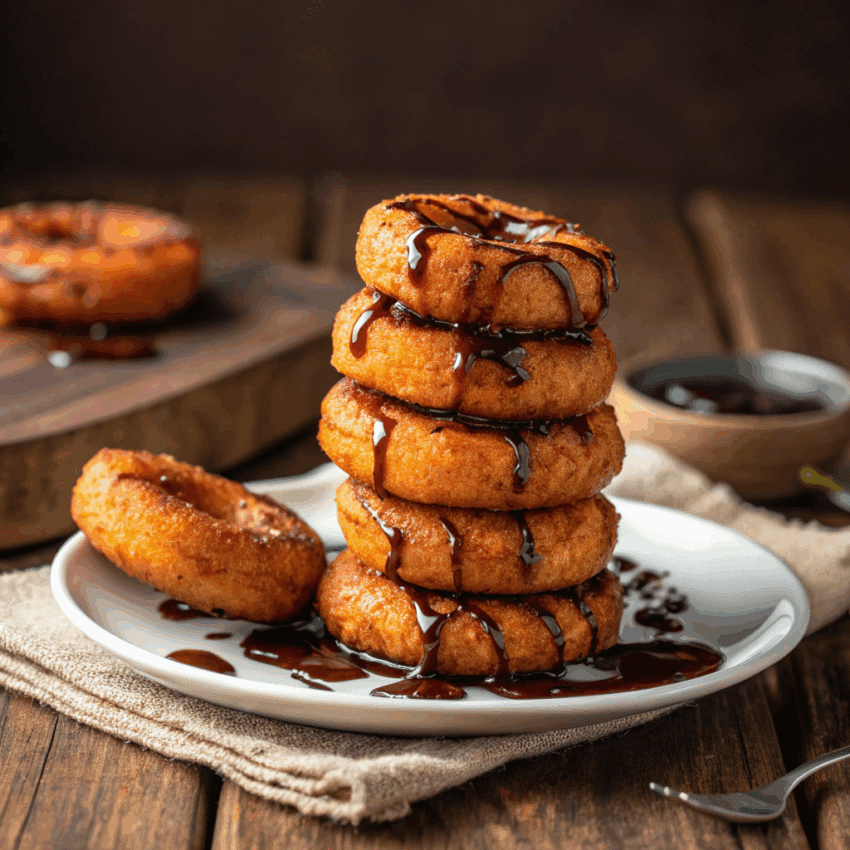If you’ve ever wandered the streets of Lima at night, you’ve likely smelled something sweet frying in the air. That irresistible scent? Picarones. These golden, ring-shaped fritters are one of Peru’s most beloved desserts, often served with a spiced syrup that clings to your fingers in the best way possible.
Today, I’m walking you through a traditional Peruvian picarones recipe so you can recreate this famous street food right in your own kitchen. No plane ticket to Peru needed—just a few pantry staples, a love for fried sweets, and maybe a nap afterward.
What Are Picarones?
Picarones are often compared to donuts, but calling them just donuts would be like calling Machu Picchu “a nice hill.” They deserve more credit.
Made with a mix of sweet potatoes and squash (yes, you read that right), the dough is fermented slightly, then fried until crisp on the outside and airy inside. Instead of the usual powdered sugar glaze, they’re drenched in chancaca syrup—a sticky, spiced molasses-like sauce made from raw cane sugar.
They’re one of the most iconic Peruvian desserts and an essential part of Peruvian cuisine. Think of them as the Peruvian cousin to churros, but with their own distinct charm.
A Quick Peek Into History
Picarones date back to colonial Peru. Spanish colonists introduced buñuelos (fritters) to the region, but locals swapped in native ingredients like camote (sweet potato) and zapallo (squash). The result? A sweet treat that blended cultures and became a national treasure.
Today, picarones are sold in every corner of Lima. They’re a must-try alongside anticuchos, another famous street food made of skewered beef heart. The combo—savory anticuchos followed by sticky, sweet picarones—is basically a late-night Peruvian dream.
Ingredients You’ll Need
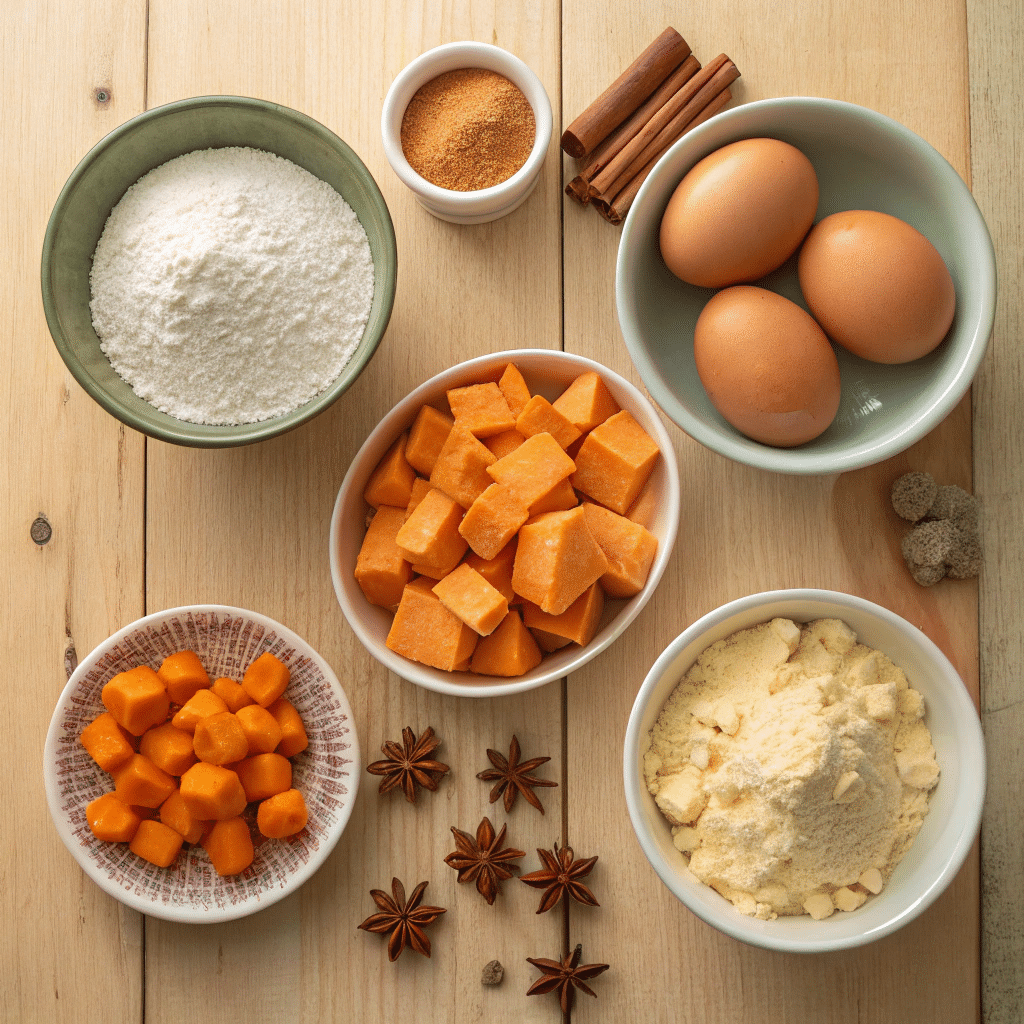
This picarones Peru recipe makes about 12–14 fritters.
For the dough:
- 1 medium sweet potato (about 250g)
- 1 cup squash or pumpkin (peeled, cubed)
- 2 cups all-purpose flour
- 1 ½ teaspoons dry yeast
- 1 tablespoon sugar
- ½ teaspoon salt
- ½ teaspoon anise seeds (optional, but authentic)
- 1 egg (lightly beaten)
- ½ cup warm water
- Vegetable oil, for frying
For the syrup (miel de chancaca):
- 8 oz chancaca (or substitute with dark brown sugar or panela)
- 1 cinnamon stick
- 2–3 cloves
- 1 orange peel strip
- 1 cup water
Step-By-Step: How to Make Picarones
Step 1: Cook the Vegetables
Boil the sweet potato and squash until tender. Drain well, then mash into a smooth puree. Let it cool to room temperature.
Step 2: Activate the Yeast
In a small bowl, combine warm water, sugar, and yeast. Let it sit until bubbly—about 10 minutes.
Step 3: Make the Dough
In a large bowl, mix the mashed sweet potato, squash, flour, salt, anise, and egg. Pour in the yeast mixture. Stir until combined. The dough will be sticky (that’s a good sign!). Cover with a towel and let it rise for about 1 ½ hours.
Step 4: Prepare the Syrup
While the dough rises, make the chancaca syrup. In a saucepan, combine chancaca, water, cinnamon, cloves, and orange peel. Simmer until thickened slightly, about 15 minutes. Strain and keep warm.
Step 5: Fry the Picarones
Heat oil in a deep pan. Wet your fingers with water, grab a portion of dough, and shape it into a ring (don’t worry if they’re imperfect—that’s part of their charm). Fry until golden brown on both sides.
Step 6: Serve
Dip the hot picarones into the syrup or drizzle generously before serving. Eat immediately—preferably with sticky fingers.
Tips for Success
- Sticky dough is normal. Don’t fight it by adding extra flour, or you’ll lose the airy texture.
- Water is your friend. Keep a small bowl of water nearby to wet your fingers before shaping the dough.
- No chancaca? Use dark brown sugar or panela—it gives a similar depth.
- Serve right away. Like most fried foods, picarones taste best when hot.
Why Picarones Deserve a Spot in Your Kitchen
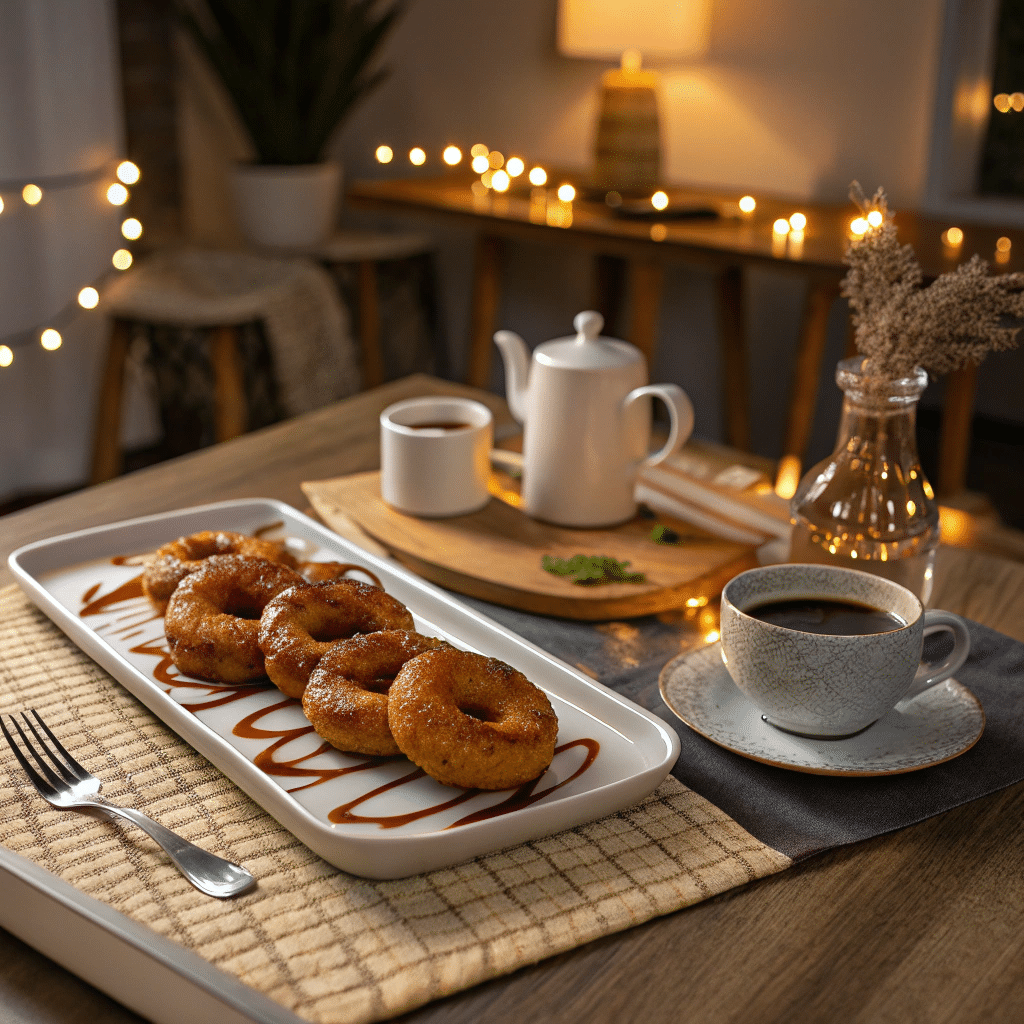
Peru is known for its Peruvian dishes that balance bold flavors with cultural history. While ceviche often steals the spotlight, desserts like picarones showcase the sweeter side of Peruvian cuisine.
They’re not just tasty—they’re also a conversation starter. Imagine serving these golden rings at a dinner party and casually saying, “Oh, I just made some traditional Peruvian snacks tonight.” You’ll instantly sound worldly, even if you’ve never set foot outside your kitchen.
Are Picarones Like Churros?
Picarones sometimes get compared to Peruvian churros. Both are fried, both are sweet, and both make you question your life choices after eating too many. But while churros are made from a simple flour dough and rolled in sugar, picarones bring in that earthy sweetness from squash and sweet potato, plus the signature syrup.
So, while they’re distant cousins in the family of fried desserts, each has its own personality.
Variations and Substitutes
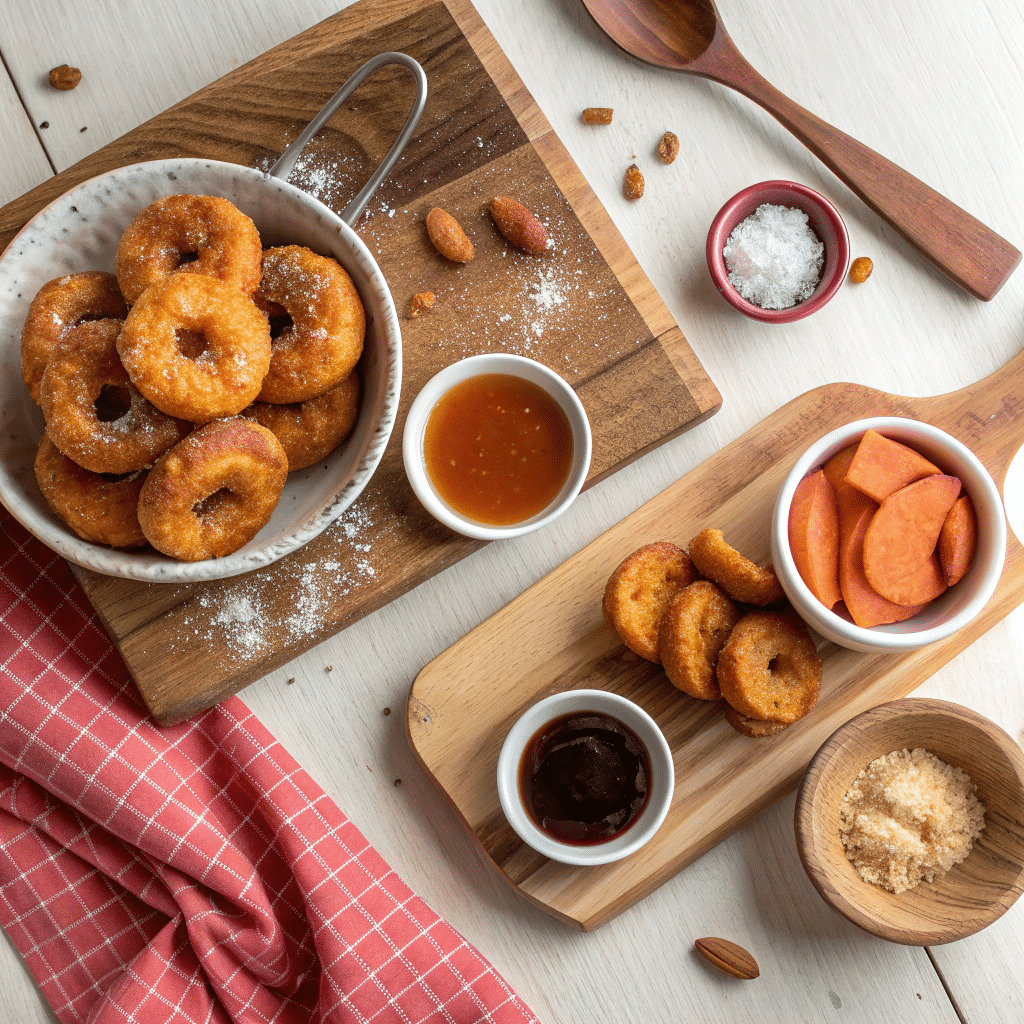
- Puerto Rican twist: Some readers might be familiar with Puerto Rican recipes that use sweet potatoes in fritters. You can try blending those flavors with the Peruvian style.
- Anticucho pairing: If you’re making traditional Peruvian anticuchos, serve them with picarones for the authentic street-food duo.
- Potato donuts: If you’re short on squash, go heavy on sweet potatoes and make what some call “Peruvian potato donuts.”
Storing and Reheating
Picarones are best fresh, but if you somehow resist eating them all, here’s what you can do:
- Store leftovers at room temperature in an airtight container for 1 day.
- Reheat in a 350°F oven for 5–6 minutes.
- Don’t microwave unless you like soggy disappointment.
Final Bite
This Peruvian picarones recipe isn’t just about frying dough. It’s about experiencing a piece of Peruvian culture at home. With their crispy edges, soft centers, and syrupy coating, these fritters deserve a permanent spot in your dessert rotation.
So go ahead—roll up your sleeves, heat that oil, and fry up some sweetness. And if you get syrup on your shirt, wear it proudly. It’s basically a badge of honor.
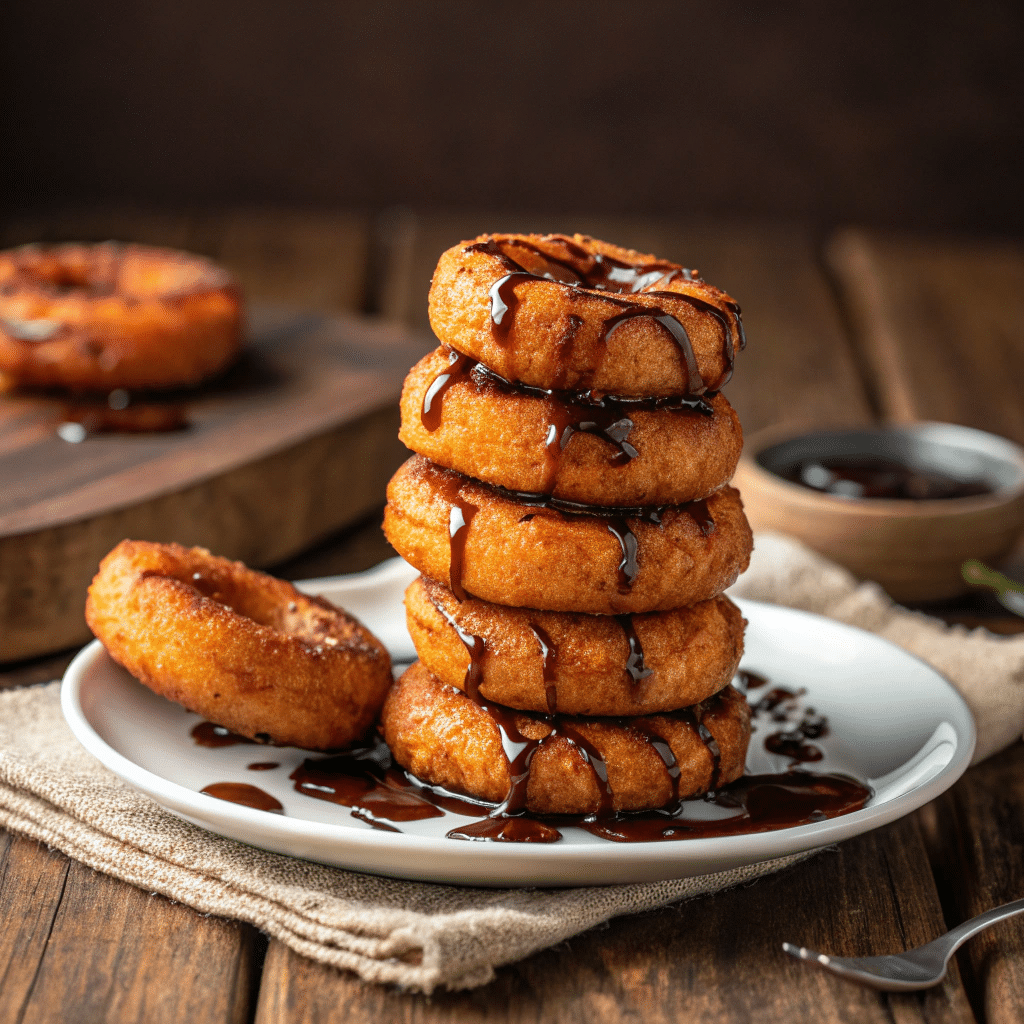
Peruvian Picarones (Sweet Potato & Squash Donuts with Syrup)
Ingredients
Method
- Boil the sweet potato and squash until soft. Drain well and mash them into a smooth puree. Let cool.
- In a small bowl, mix warm water, sugar, and yeast. Let sit for about 10 minutes until foamy.
- In a large bowl, combine the mashed sweet potato, squash, flour, salt, anise seeds, and egg. Add the yeast mixture and stir until sticky dough forms. Cover with a towel and let rise for about 1 ½ hours.
- While the dough rises, combine chancaca, water, cinnamon, cloves, and orange peel in a saucepan. Simmer for 15 minutes until slightly thickened. Strain and keep warm.
- Heat oil in a deep frying pan. Wet your fingers with water, grab a small portion of dough, shape it into a ring, and carefully drop into the hot oil. Fry until golden brown on both sides.
- Serve the picarones hot with warm chancaca syrup drizzled on top. Eat right away for best taste.
Notes
- The dough will be sticky—don’t add extra flour. Wet fingers make shaping easier.
- Chancaca gives the most authentic flavor, but dark brown sugar works as a backup.
- Serve immediately; these lose their crispness if left sitting too long.
Frequently Asked Questions
1. Can I make picarones without yeast?
You can try baking powder, but you’ll lose the slight tang and airy rise. Yeast is worth it.
2. Are picarones vegetarian?
Yes! The basic recipe is vegetarian.
3. Can I use canned pumpkin instead of fresh squash?
Yes, canned pumpkin works fine. Just make sure it’s not pumpkin pie filling.
4. How long does the dough need to rise?
About 1 ½ hours, or until doubled in size.
5. Is chancaca syrup really necessary?
It makes the dish authentic, but you can use maple syrup in a pinch.

